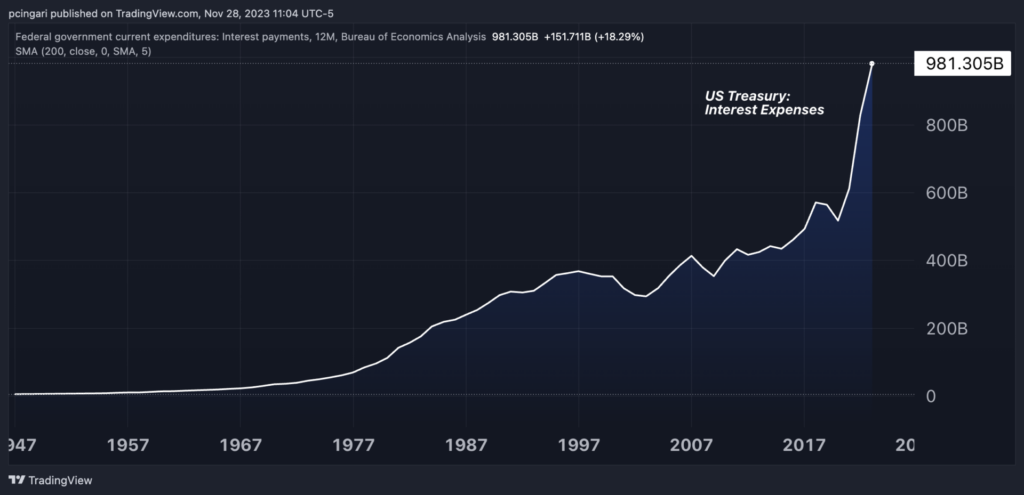Zinger Key Points
- Federal Reserve shifts from profit to loss, no longer contributing to Treasury, raising concerns amid soaring interest expenses.
- Aggressive monetary policy now strains Fed's finances, while the Treasury grapples with $1 trillion interest costs in 2023.
- In a market dominated by tariff tensions, geopolitical surprises, and Fed uncertainty, Matt Maley's technical approach delivers clear entry & exit points for consistent income potential. Try it free for 7 days
Fed’s Income Shortfall Puts Pressure On Treasury As Interest Expenses Soar To $1 Trillion 1
1
Instead of dishing out excess earnings to the U.S. Treasury, the Federal Reserve is now projected to operate as a loss-making entity for the foreseeable future.
The St. Louis Federal Reserve dropped this bombshell in a recent blog post, and it’s causing some ripples.
This situation, born out of the current aggressive monetary policy stance, not only impacts the Fed’s financial health but also adds strain to the Treasury, especially as it grapples with interest expenses surpassing $1 trillion in 2023.
How Fed’s Remittances To The US Treasury Actually Work
Historically, the Federal Reserve has generated funds by earning interest on a massive portfolio of securities obtained through its open market operations. They’ve also been cashing in on service fees.
This income usually outpaced their operational costs, and the extra cash was handed over to the U.S. Treasury to boost federal government revenue.
For most of the last decade, the Fed was transferring a hefty sum every month, ranging from $5 billion to $10 billion, to the Treasury. In fact, between 2011 and 2021, they showered the Treasury with over $920 billion, Federal Reserve Bank of St. Louis economists Miguel Faria e Castro and Samuel Jordan-Wood wrote.
The Fed’s contributions to GDP and government receipts were a mere 0.2% and 1.3% in 2007. Fast-forward to 2015, and those numbers had swelled to 0.6% and 3.4%, respectively.
Also Read: Investors Are Fleeing China – One Data Point Went Negative For First Time Ever
Why The Fed Is Now A Loss-Making Entity
The St. Louis Federal Reserve has highlighted the current financial challenges faced by the Fed. What are the implications when the Fed’s earnings are insufficient to meet its operational expenses?
As the Federal Reserve raises policy rates and trims its balance sheet (a process known as quantitative tightening), it’s encountering a rise in interest expenses on its liabilities, due to the growing interest paid on bank reserves.
On the flip side, the interest income generated from its assets is adjusting at a slower pace. This problem has been exacerbated during the ongoing tightening cycle, where policy rates are shooting up at an unprecedented rate.
When the Fed’s expenses surpass its income, it results in a “deferred asset,” which is essentially a fancy way of saying they’re in the red.
Yields on U.S. Treasury bonds, the most representative asset on the Fed’s balance sheet, have skyrocketed over the past two years, leading to an unprecedented drop in the securities’ market value. The popular iShares 20+ Year Treasury Bond ETF TLT has seen its value shrinking for three straight years, by 6% in 2021, 33% in 2022 and 8% so far this year.
According to the St. Louis Fed, we can expect the Fed to carry this financial burden until it turns a profit again, likely in 2025. Only then will it resume sharing its gains with the Treasury, probably around mid-2027.
Chart: Debt Burden Escalates – US Treasury’s Interest Expenses Poised To Hit $1 Trillion By Year-End

What Does It Mean For The Fed And The Treasury?
This financial shortfall doesn’t hinder the Fed’s ability to carry out its monetary policies or meet its financial obligations. However, it does have implications for the money flow between the Fed and the Treasury.
With the Treasury’s interest expenses on its ever-growing debt predicted to breach the $1 trillion mark in 2023, it raises an important question: Will there be more discourse in Congress about the Federal Reserve’s interest rate policies?
This issue becomes increasingly relevant as we enter the final year of a presidential cycle, a period typically characterized by heightened focus on economic policies and financial stability.
Read now: S&P 500 At 5,000 In 2024? Bank of America’s Optimistic Forecast Diversifies Beyond Magnificent 7
Photo: Shutterstock
Edge Rankings
Price Trend
© 2025 Benzinga.com. Benzinga does not provide investment advice. All rights reserved.
Trade confidently with insights and alerts from analyst ratings, free reports and breaking news that affects the stocks you care about.